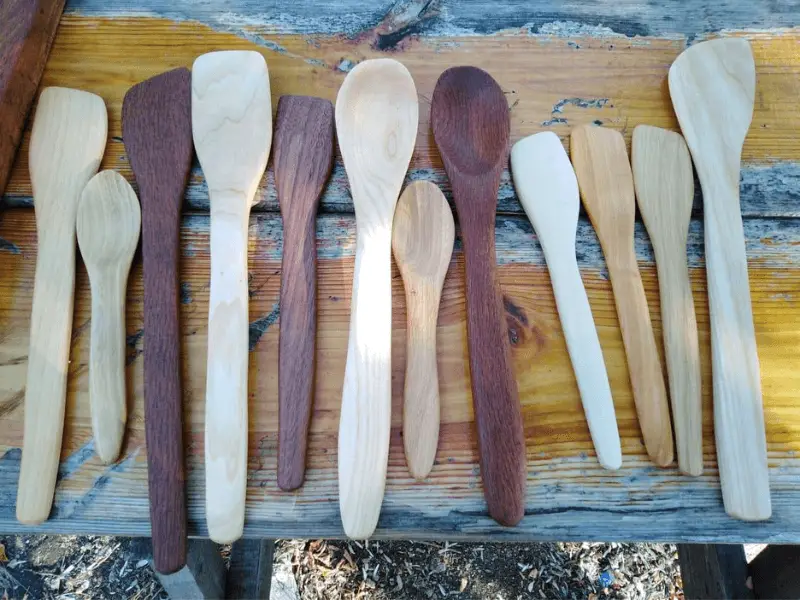When it comes to kitchen utensils, you want to be sure that you make the best choices with the materials they’re made from, as these tools can be used daily for years. Wood is an excellent choice, as it’s durable, aesthetically pleasing, and provides many benefits that plastic or other materials can’t match. However, there are many different types of wood out there, and choosing the right one can be difficult if you don’t know where to look. What type of wood is suitable for kitchen utensils?
Hardwoods are the best types of lumber to make kitchen utensils because they are unique and durable. Maple, cherry, birch, and oak are the most common woods used in kitchen utensils. Each type of wood has distinct advantages, making it an important consideration when selecting utensils and other equipment.
However, hard maple and beech are substantially trickier to carve if you aren’t familiar with them.
The following is what you need to know about the many varieties of wood used in kitchen utensils to help you pick the best solution for your needs.
Best wood for cooking utensils
Choosing the best wood type for kitchen utensils depends on your cooking type and the knives you often choose. Different woods offer different benefits, so here’s an overview of some of the most popular types of wood and which ones are best suited to your needs.
Read Next
- Best Wood for Cooking Utensils
- Carve Spoons from Dry Wood
- What Knives Do I Need to Carve a Spoon
- Wood Carving Tips for Beginners
- Best Carving Knife for Every Skill Level
- Beginner’s Guide to Woodcarving Gouges
1. Hard maple
It is also known as sugar maple, popularly used in North America. It is a beautiful light natural wood with a shiny, glossy finish when sanded or sealed.
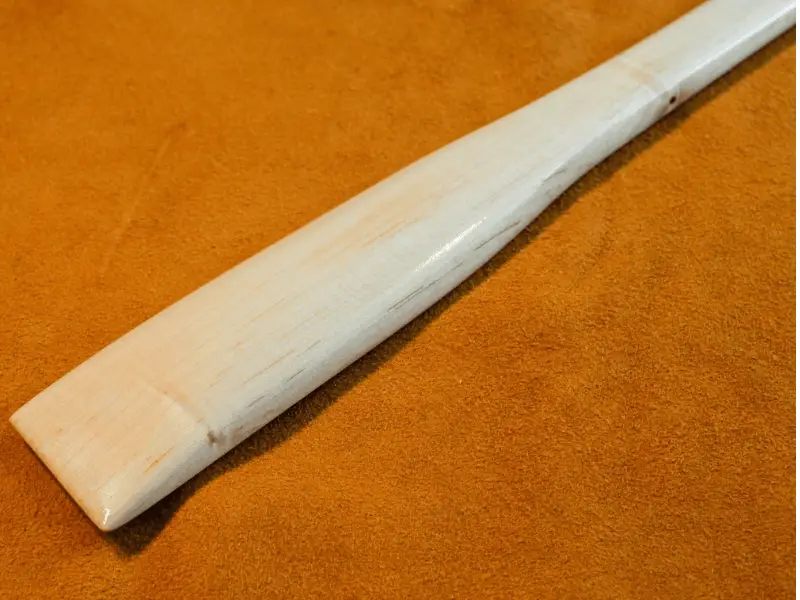
Wood from maple trees will be an excellent choice for all your wooden spoons and ladles. Maple has an exceptionally tight grain, making it harder to scratch on your cookware. You may need to polish these pieces periodically to keep them looking their best, but they’ll last longer than other woods with less maintenance.
2. Mexican Ebony
It is also known as katalox. This sort of Hardwood is one of the hardest woods that gives unique woodwork if employed in a project. It is dark purplish and has a thick grain.
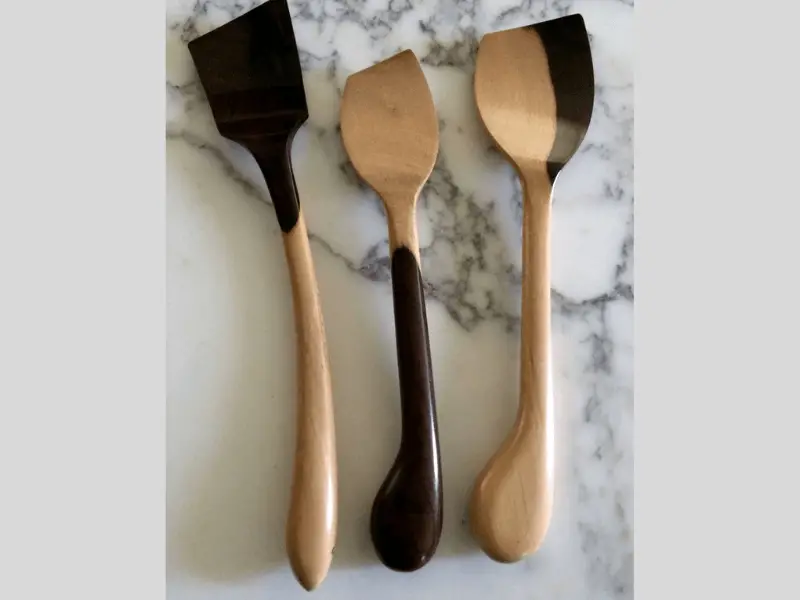
Ebony has always been considered a top choice of quality wooden handles because it possesses several desirable properties. It is easy to shape, creates tight joints, and has a fine grain that allows for smooth finishes.
However, Mexican Ebony is challenging to work with and, therefore, unsuitable for beginners.
3. Bloodwood
A stunning wood, bloodwood is one of our favorite types to work with. Its deep burgundy and crimson color make it an excellent choice for kitchenware—and with a fine texture, it adds a touch of elegance.
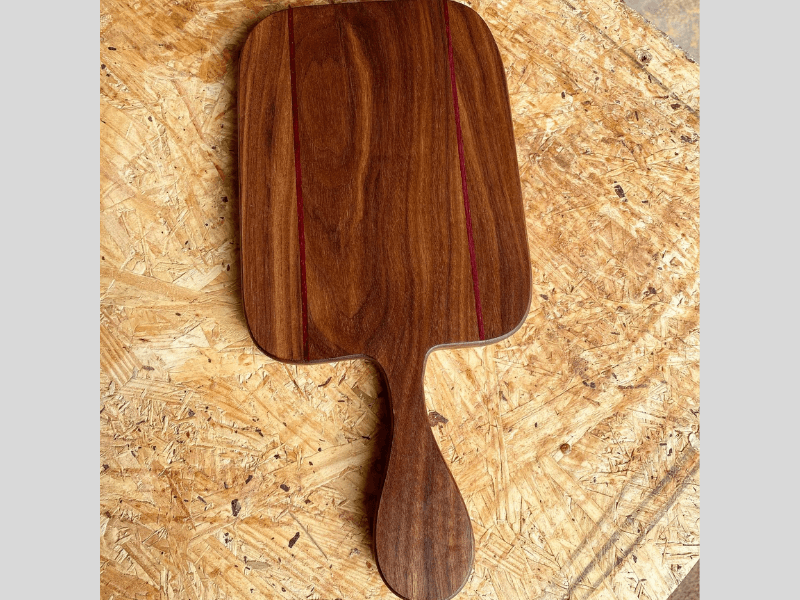
But, it’s also prone to cracking over time. We recommend using bloodwood only on larger pieces like serving spoons and ladles. Otherwise, you’ll need to worry about preserving its luster constantly.
Also, working with bloodwood requires you to pay total attention to grain orientation and, therefore, might not be easy for those in the game.
4. Brazilian Cherry
Hardwood is also known as Jatoba; it is found in South and Central America. It is a challenging and durable wood with beautiful brown heartwood. Although it turns darker when exposed to more light, it retains its natural color when seasoned and adequately cared for.
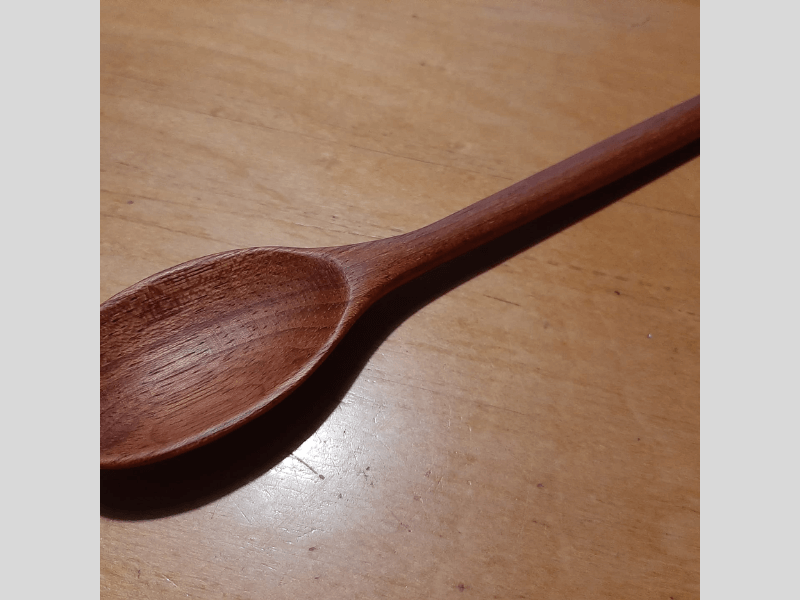
However, its grains can crack and split when exposed to changes in temperature or humidity, making them prone to premature wear and tear.
That said, Brazilian cherry is naturally resistant to bacteria and fungus growth, even when exposed to moisture—like if you leave your wooden spoons in a wet sink. When adequately dried after exposure, it won’t warp or shrink.
5. Chestnut
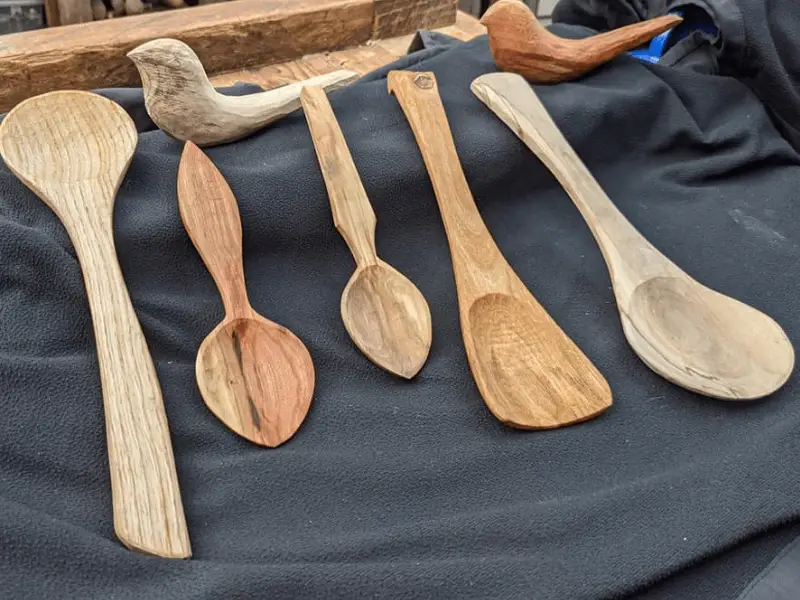
We propose chestnut as material if you want a beautiful look and feel; not only does it come in attractive colors like brown and dark reds, but it also has antibacterial characteristics that prevent bacteria from forming in or around your kitchen. It also won’t splinter when cut, making it safe for most users.
6. Birch
Birch is a gorgeous, pale-colored hardwood that’s durable and stable. It makes for high-quality cutting boards and serving platters. If you have a birch board or two at home, you probably love how it can withstand practically everything you throw.
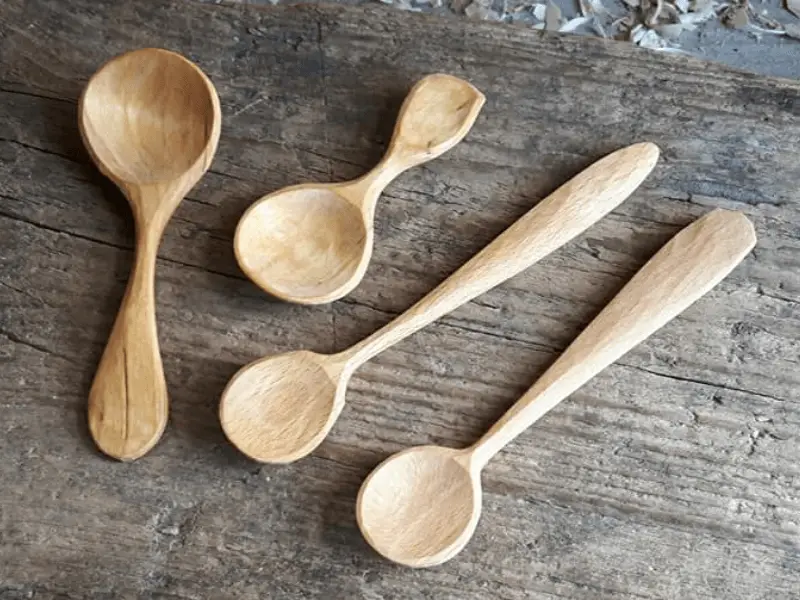
But if your cutting board isn’t properly maintained (i.e., lubricated regularly with mineral oil), it can deform over time owing to moisture trapped in its pores. In addition, chopping straight on your board might scar and dull its surface. Keep yours looking fresh by cleaning it with soap and water once per week; dry fully before oiling with mineral oil (to guard against mold formation) (to protect mold growth). And then be ready to prepare some great dinners!
Comparing appearance and durability
| wood type | appearance | Durability |
| Hard maple | creamy white with a slight reddish tinge. | great |
| Mexican Ebony | dark purplish | better |
| Bloodwood | deep burgundy and crimson color | good |
| Brazilian Cherry | brown | good |
| Chestnut | brown and dark reds | great |
| Birch | pale-colored | great |
Hard vs. Soft: Which is Better?
Once you understand the different types of wood and what they’re best used for, you can decide which wood will suit your needs best.
From the ancient period, two types of wood are popularly known, and they include:
- Hardwood
- Softwood
The distinction between these two types of wood is determined not by their hardness or softness but by their grain structure and mode of water transport.
Although beginners always prefer working with softwoods since they are cheaper and easier to deal with, in our opinion, hardwoods (like beech) offer higher resilience and longevity compared to softwoods (like maple) (like maple). However, it comes down to your preference — we all have different demands when deciding what tools we employ.
However, we have our reasons why we believe that hardwoods are the most recommended type of wood for your kitchen utensils :
Why Hardwoods are better for kitchen utensils
They are rigid and robust.
Most hardwoods are more rigid and more robust, making them a good surface area to work on. They are less likely to warp and crack, making them the best choice for your wooden utensils.
They are durable.
Besides being rigid and robust, hardwoods are also popularly known to resist harsh environmental conditions and last a long time. That is precisely what we want for our wooden kitchen items.
They easily retain their beautiful natural wood color.
Hardwoods like Brazilian cherry and Satine have a natural dark color that makes their grain unique. The uniqueness in those hardwoods makes it easy for you to produce perfect quality wooden utensils for your beautiful kitchen.
They have high fire resistance.
Hardwoods are more heat resistant than softwoods due to their thickness and toughness. People prefer using them for their wooden kitchen utensils as they burn when subjected to heat.
Easily Maintained
Kitchen utensils made from Hardwood are easy to clean and do not crack or scratch easily.
Even though hardwoods are the best choice for making kitchen utensils, it is good to know that not all types of hardwoods are safe for kitchen use. For example, hardwoods like poplar are very porous and quickly absorb moisture, while walnuts and fruitwoods contain toxic substances that can cause foul odors or food poisoning.
Challenges of Working with Hardwood
Accessibility
Hardwood lumber grows best in fertile lands with the best weather conditions. They also grow slower than softwoods, making them hard to obtain in local timber stores.
Drying Rate
Even though hardwoods are hard to work on, they also take a long to dry. Some hardwoods, like bloodwood, take 3 to 4 months before they are ready for your projects. So for you to make perfect and unique kitchen utensils from Hardwood, you should practice patience.
Not Easy for beginners
It is not easy to work with hardwoods. They blunt every tool they use and can cause bodily harm if not carefully handled. Anyway, a good woodworker does not settle for less. We maintain high standards and produce perfect and unique kitchen utensils for our customers using Hardwood.
Since it is not easy for beginners to work with Hardwood, let’s look at tips to help them work well.
Tips for Beginners on How To Work with Hardwoods
- Learn the basics about woodwork
- Work hard to master rules followed by artisans and woodworkers when working with hardwoods.
- Make sure you learn and understand the traits and behaviors of each wood type.
- Use specialized tools while working on your projects.
- Create a good working environment before you start working on your projects.
- Draft your designs and work on them passionately using appropriate materials to get your desired outcome.
How to choose a hardwood
When selecting Hardwood for your cookware, it’s essential to pick a durable yet flexible option.
Forks, spoons, and spatulas can benefit from solid Hardwood due to its durability and ability to withstand temperature changes.
If you’re searching for something more raw and classic, a piece of oak or walnut will make a great addition to your galley.
Remember that there are also many different types of maple: The more rigid varieties are better suited for items that come in contact with food; select softer varieties if you intend on using your utensil strictly for display purposes.
Though maple may be one of the most popular options, remember that other trees, such as cherry and hickory, have their attributes. Cherry bowls are elegant but sturdy, while hickory is known for being exceptionally dense—you may want to experiment with both before committing to one style!
To help narrow your search, here are a few additional factors: age, quality, and finish.
Age refers to how long ago the tree was cut down (old-growth tends to be more robust), while quality determines whether or not you’ll have knots, bubbles, or other imperfections.
Lastly, finish affects appearance and maintenance; glossier materials stain easier than matte finishes and require constant upkeep to prevent discoloration. These aspects play a vital role in picking a material that’s perfect for you. Everything boils down to finding a middle ground price point and usability, so make sure you evaluate everything before making a final decision!
Benefits of wooden kitchenware
Wooden tools are generally more environmentally friendly than plastic or metal because they are made from renewable resources that decompose back into nature. Plus, wooden cooking tools can be better at conducting heat and holding it longer than most metals.
Furthermore, wooden handles provide an excellent non-slip grip and help prevent hand fatigue. Finally, many owners rave about how pleasant these utensils feel in their hands while they’re cooking.
Numerous studies have been done on whether using wooden spoons can change your brain chemistry to make you more relaxed! While results are mixed on whether you end up feeling calmer during meal preparation (likely due to placebo effects), people who believe they will become favorable report feeling after handling them. And if there’s one thing everyone needs when preparing food for family and friends… it’s peace of mind!
Are our wooden utensils safe?
Wood, especially bamboo and other natural woods that are non-porous, has many advantages over plastic, including being durable, easier to clean, and more eco-friendly. Wood won’t transfer any unwanted flavors or chemicals into your food (unlike some plastics), and it will be gentler on your hands while cooking.
Wood is also a better insulator than plastic, so you can expect to hold a hot wooden spoon longer than one made from another material.
However, there are a few downsides to using wood utensils when cooking:
- Even though natural oils will not leach into your food, they may still emit their odor while cooking;
- Because of their flexibility, your spoons may feel less firm.
- And since wooden utensils tend to absorb liquids, you must always dry them before storing them.
Numerous types of wood we use for kitchenware, including cherry, teak, bamboo, and walnut. Each type has its advantages and disadvantages, depending on what you’re looking for in a utensil.
For example, cherrywood looks beautiful but is quite soft; teak holds up well but stains easily; bamboo gets stronger with age but can break if frozen or dropped unexpectedly on hard surfaces. With that said, it depends on your preferences when choosing between wooden and plastic utensils. Bamboo handles have become increasingly popular recently because of their durability and attractiveness. Handles endure longer than most wooden utensils because of reduced friction during use (due to less contact with pots and pans) and heat resistance during cleaning operations.
Bottom Line
Suppose you read this article from the beginning to the conclusion; well done! You are now the best for crafting kitchen utensils utilizing Hardwood. But remember, the fact that I appreciate using Mexican Ebony to build my wooden cooking tools doesn’t mean it should also be your decision.
Choose what fits you and work on it to generate exquisite and original wooden tools for your kitchen.
